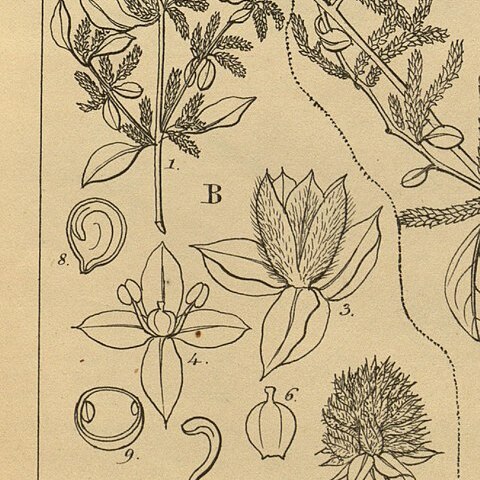Annual herb, (4–)10–45 cm., with many spreading branches from about the base upwards; stem and branches subterete, striate, glabrous or thinly hairy.. Leaves narrowly to broadly elliptic, elliptic-oblong or ovate, entire, thinly hairy to glabrous, obtuse to subacute at the tip, blade of the lower main stem leaves ± 10–40(–50) × 6–20 mm., gradually or more abruptly narrowed to a petiole about half the length of the blade, upper and branch leaves becoming shorter and narrower.. Flowers in dense 3–15 × 2 2.5 mm. spikes which are clustered in the leaf-axils of the stem and branches or on very short axillary shoots; spike sessile or the terminal spike on axillary shoots shortly (to ± 3 mm.) pedunculate; inflorescence-axis thinly to rather densely pilose; bracts hyaline, minutely erose, concave, acute or shortly acuminate, ± 0.5 mm., glabrous or very thinly hairy; bracteoles minute, hyaline.. Perianth-segments broadly ovate, ± 1.25 mm., subacute to shortly acuminate, villous on the outer surface in the basal two-thirds with a thick greenish vitta and a central rib.. Stamens longer than ovary and style.. Capsule included, falling with the persistent perianth.. Seed ± 0.4 m., chestnut-brown, smooth and shining.. Fig. 20.
Stem usually much branched, often so from near the base, 0.10-0.60, glabrous. Leaves elliptic or ovate-elliptic from an acute base, obtuse or acute, minutely mucronate, thinly herbaceous, green, quite glabrous, 2-5 by ½-2 cm; petiole 4-8 mm. Spikes very numerous, for the greater part in clusters of 3-8, rarely solitary or paired, erect or patent, sessile or shortly stalked, ½-1½ cm long, cylindric with rounded apex, white; bracts and bracteoles glabrous, in sicco white, patent; bracts ovate acute, ± 1 mm long; bracteoles slightly smaller. Tepals ± 1¼ mm long, oblong, acute, nerveless, bluish red (ex WINKLER; in the specimens seen by me in sicco white), patently villous outside. Stamens 1-2; filaments very thin, anthers minute, style hardly perceptible. Utricle falling off with the enclosing perianth. Seed shining, brownish black, ± ¾ mm diam.
Flowers in dense, 3–15 × 2–2.5 mm. spikes which are clustered in the leaf-axils of the stem and branches or on very short axillary shoots; spikes sessile or the terminal spike of axillary shoots shortly (to c. 3 mm.) pedunculate; inflorescence axis thinly to rather densely pilose; bracts hyaline, minutely erose-denticulate, concave, acute or shortly acuminate, c. 0.5 mm., glabrous or very thinly hairy; bracteoles minute, hyaline.
Leaves narrowly to broadly elliptic, elliptic-oblong or ovate, thinly hairy to glabrous or almost so, obtuse, subacute at the apex, at the base gradually or more abruptly narrowed to a petiole about half the length of the lamina, lamina of the lower main stem leaves c. 10–40 (50) × 6–20 mm., upper and branch leaves becoming shorter and narrower.
An annual herb. It grows 10-45 cm high. The leaves are narrowly oval. They are 10-40 mm long by 6-20 mm wide. They taper towards the leaf stalk. The flowers are in dense spikes. The seed are about 0.4 mm across.
Perianth segments broadly oval-elliptic, c. 1.25 mm. long, subacute to shortly acuminate, villous on the outer surface, in the basal two-thirds with a thick greenish vitta and a single midrib.
Annual herb, (4) 10–45 cm., with many spreading branches from about the base upwards; stem and branches subterete, striate, glabrous or thinly hairy.
Capsule included, falling with the persistent perianth.
Seed c. 0.4 mm. chestnut-brown, smooth and shining.
Erect or straggling, branched herb, to 2 ft. high
Stamens longer than the ovary and style.
Flowers white.

